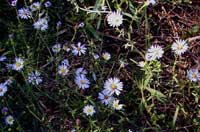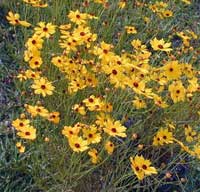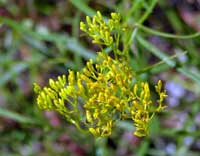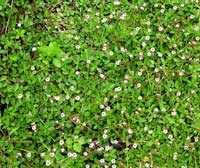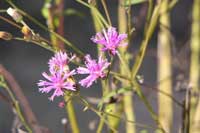Propagation of Five South Florida Plant Species for Urban Horticulture
Project Director: Mary Collins, Senior Horticulturist
Project Participants:
Carl E. Lewis, Ph.D., Richard H. Simons Senior Curator
Anne Frances, Conservation Research Assistant
Ken Neugent, Nursery Manager
Sponsored by Florida Wildflower Advisory Council
Fairchild Tropical Botanic Garden horticulturists conducted experiments with the goal of perfecting propagation techniques for five native wildflower species suitable for pine rocklands and other roadside habitats of South Florida.
Objectives
We conducted a one year project to study five promising, ornamental native pineland species, with the following goals:
- To increase the awareness of and appreciation for Florida native wildflowers through outreach
- To determine the best propagation techniques and cultural practices for selected species of wildflowers
- To distribute information about their propagation and cultivation to the local community
- Public plantings in Fairchild Tropical Garden to demonstrate the value of these species in urban horticulture
Five South Florida study species were selected on the basis of their adaptability to a wide range of conditions, ornamental qualities, value to pollinators, and potential value to urban landscaping.
Methods and Results
| Date | Activity |
|---|---|
| March 1 | seeds of AD, CL, and FL placed in storage for six months |
| March 11 | seeds of AD, CL, and FL placed in storage for one month |
| April 12 | trial of AD, CL, and FL in one month storage begun |
| May 14 | trial of VB fresh seed begun |
| May 18 | trial of VB “empties” begun |
| May 18 | seeds of VB placed in storage for one month |
| June 7 | trial of AD, CL, and FL in one month storage terminated |
| June 21 | trial of VB in one month storage begun |
| July 21 | trial of Phyla nodiflora in one month storage (ambient temperature) |
| September 1 | trial of AD, CL, and FL in six months storage begun |
Seven different propagation treatments were studied during the grant period as outlined at right. The techniques and resulting data are described below.
Treatment A:
One month storage of Aster dumosus, Coreopsis leavenworthii, and Flaveria linearis at different temperatures (23°C, 12°C, and -20°C) to test viability after short term storage.
Methods:
Seeds of the three species were cleaned and counted into 10 packets of 10 seeds each, for each of the three storage temperatures. We discarded seeds that were small, discolored, or appeared empty. However, due to the small size of the seeds, it is possible that some undeveloped seeds were included in the samples. The seeds were held in a desiccator from March 8 through March 11 and were kept at a relative humidity of between 18 to 21%*. On March 11, the seeds were packaged in airtight barrier foil packs and placed in the refrigerator (12°C), the freezer (-20°C), and the ambient temperature room (23°C). Germination trials began on April 12, 2004. All seeds were planted in a soil mix consisting of 30% Canadian peat, 20% coarse sand, 10% composted bark, and 40% perlite. Data were recorded on a weekly basis for 8 weeks.
Results:
Germination data for Treatment A are listed in Appendix A. Seeds of Aster dumosus stored at ambient temperatures (23°C ) had a germination percentage (53% ± 23.26%) comparable to those stored at 12°C (66%, ± 16.25%) and those stored at –20°C (60% ± 17.89% ). Seeds of Coreopsis leavenworthii stored at 23°C (80% ± 12.65%) also had a germination percentage comparable to those stored at 12°C (71% ± 17.58%) and –20°C (74% ± 12.00%). Due to extremely small size, it was difficult to be sure that the seeds of Flaveria linearis were viable. Lower germination percentages were observed for this species at all storage temperatures. Again, seeds stored at 23°C had a germination percentage (25% ± 12.04%) comparable to those stored at 12°C (21% ± 11.36%) and –20°C (32% ± 17.78%). The results of Treatment A show that Aster, Coreopsis, and Flaveria seeds were viable even after one month storage at temperatures below freezing. Germination did not appear to be promoted or inhibited by any temperature treatment.
Treatment B:
Six month storage of Aster dumosus, Coreopsis leavenworthii, and Flaveria linearis at different temperatures (23°C, 12°C, and -20°C) to test viability after longer term storage.
Methods:
Using the same methods seed sources described for Treatment A, seeds were cleaned and counted into 10 packets of 10 seeds each for each of the three storage temperatures. The seeds were held in a desiccator from February 24 through February 27 and were kept at a relative humidity of between 18 to 21%. On February 27, the seeds were packaged in (air-tight) barrier foil packs. They were held in the ambient temperature room (about 23°C) from February 27 through March 1 so they could equilibrate within the foil packs. On March 1, 100 seeds each of the three species (Aster dumosus , Coreopsis leavenworthii, and Flaveria linearis) were placed in the refrigerator (12°C) and in the freezer (-20°C), leaving the remaining seeds in the ambient temperature room (23°C). Germination trials began on September 1, 2004. Vernonia blodgettii and Phyla nodiflora were not included in this trial because there were not enough viable seeds. Data were recorded on a weekly basis for a period of 6 weeks (due to the end of the grant period).
Results:
Germination data for Treatment B are listed in Appendix B. Seeds of Aster dumosus stored at 23°C (50% ± 10.5%) had a germination percentage comparable to those stored at 12°C (48% ± 10.3%) and –20°C (43% ± 15.7%). Seeds of Coreopsis leavenworthii stored at 23°C (72% ± 15.5%) also germination percentage comparable to those stored at 12°C (83% ± 13.4%) and –20°(71% ± 12.9%). Seeds of Flaveria linearis stored at –20°C (4% ± 5.2%) had a lower germination rate than those stored at 12°C (20% ± 17.6%), and 23°C (25% ± 12.7%). Even after storage in cold (12°C) or below freezing temperatures (-20°C), the results of the Coreopsis seed trials show that these are good candidates for long term storage. The Aster seed trials, although lower percentage germination than Coreopsis, show that this species may also be used in long term storage. The results of the Flaveria seeds trials show that cold storage may not be an option for this species.
Treatment C:
One month storage of Vernonia blodgettii at different temperatures (23°C, 12°C, and -20°C) to see if the seeds retain their viability.
Methods:
Seeds of V. blodgettii were cleaned and counted into 10 packets of 10 seeds each, for each of the three storage temperatures. To the best of our ability, we discarded seeds that were small, discolored, or appearing empty. However, due to the small size of the seeds, it is possible that some undeveloped seeds were included in the samples. The seeds were held in a desiccator from May 18 through May 21 and were kept at a relative humidity of between 19 to 22%. On May 12, the seeds were packaged in (air-tight) barrier foil packs, and 100 seeds were placed in the refrigerator (12°C), the freezer (-20°C), and the ambient temperature room (23°C). Germination trials began on June 21, 2004. Data were recorded on a weekly basis for a period of 8 weeks.
Results:
Germination data for Treatment C are listed in Appendix C. Seeds kept at ambient temperatures (23°C) showed the lowest percent germination (33% ± 17.7%). Seeds stored at –20°C had a higher germination rate (58% ± 11.4%), as did those stored at 12°C (50% ± 20.0%).
Treatment D:
One month storage of Phyla nodiflora stored at ambient temperatures (23°C). Due to a lack of seeds, other storage treatments did not take place.
Methods:
Phyla nodiflora flowers all year, but infructescences did not develop until June. The infructescences were collected and allowed to dry at room temperature for 2 weeks. Seeds of Phyla nodiflora were cleaned and counted into 10 packets of 10 seeds each. To the best of our ability, we discarded seeds that were small, discolored, or appearing empty. Seeds were maintained at room temperature from June 21 to July 21. 50 seeds, from 5 packets were planted in each of 2 containers. Further study will be done regarding the effect of different temperatures on viability at a later date. Germination trials began July 21.
Results:
Germination data for Treatment D are listed in Appendix D. In one container of 50 seeds, 20 germinated (40%). In the second container, 24 of the 50 seeds planted germinated (48%). Further experimentation will take place with storage of seeds at 23°, 12°C and –20°.
Treatment E:
Preliminary study of vegetative propagation in Vernonia blodgettii using root cuttings.
Methods:
Vernonia blodgettii root cuttings were taken March 1. There were 24 - 4” long roots, 24 - 2 ½” long, each planted in an upright position in our seedling soil mix. There were 50 – 2½“ root cuttings and 33 – 4” root cuttings planted in a horizontal position.
All cuttings were in a greenhouse with misting every 6 minutes for 4 seconds.
Results:
Within 7 days of planting, those roots in an upright position (with top of root exposed ¼”), a reddish coloration was noted. This change in pigment may be due to exposure to light. None of the vertically oriented roots produced upright shoots and after 2 months, only one of the root cuttings survived. The horizontally oriented roots, 3 of the 50 root cuttings that were 2 ½” long produced leaves, and new roots. In the flat of 33 - 4” long root cuttings, only 1 produced leaves and new roots. Continued work is needed with root cuttings of Vernonia.
Treatment F:
Preliminary study of vegetative propagation in Vernonia blodgettii using stem cuttings.
Methods:
20 stem cuttings of Vernonia were taken August 4, approximately 12” long, dipped in Rootone and placed in perlite. 20 stem cuttings were taken, approximately 12” long, dipped in Hormodin 2, and placed in perlite. All cuttings were in a greenhouse with misting every 6 minutes for 4 seconds.
Results:
All cuttings showed a quick decline and total necrosis occurred within 3 weeks. Although first results are not favorable, further study is needed.
Treatment G:
Preliminary study of vegetative propagation in Flaveria linearis using stem cuttings.
Methods:
Flaveria stem cuttings were taken June 2. Seven cuttings were planted in each container of perlite. There were 3 treatments with 4 pots (28 cuttings) of each treatment; no hormone, Rootone, Hormodin 2. All cuttings were in a greenhouse, under mist every 6 minutes for 4 seconds.
Results:
Cuttings were checked after 2 months, August 4. By this time many of the stem cuttings had declined. Further study is needed.
Discussion
The study showed that the subtropical to tropical Aster dumosus, Coreopsis leavenworthii, and Vernonia blodgettii may be stored successfully in freezing temperatures. There is a need for even longer term storage studies for these species. As a result of the seed storage studies of 1 - month and 6 - month durations it appears that there is no benefit to storing at freezing temperatures. It appears that Flaveria linearis is not a candidate for storage in freezing conditions. The percentage of seed germination of Flaveria linearis was 32% or below, regardless of the treatment or length of storage. However, due to the small size of the seeds, it is possible that some undeveloped seeds were included in the samples.
Coreopsis leavenworthii is easily grown from seeds, as demonstrated by the relatively high germination rates under all storage conditions. Vernonia blodgettii and Aster dumosus, although slower to germinate and grow than Coreopsis, are also easily grown from seeds.
Seeds of Flaveria linearis are tiny and difficult to handle. Spontaneous seedlings appear readily within established plantings at Fairchild. Seedlings may be taken from the ground and grown in pots with a high rate of success.
Although vegetative propagation experiments with Phyla nodiflora have not been conducted to date, the species appears to be an excellent candidate for propagation by cuttings. Its stems produce roots at each node when in contact with soil, creating a natural mat. As of this date, no vegetative propagation experiments with Coreopsis or Aster have taken place. These will be done as well as further work with Phyla, Vernonia, and Flaveria at a later date.
